Sage Magazine is honored to award Lauren Greyson’s “Untamings: Two Essays on the German Post-natural” as a co-winner in our 2015 Emerging Environmental Writers Contest.
Honeymoon Hole
If, upon finding yourself in the north of Cologne, you stumble upon the broom path leading to the blackberry heath, then you’re nearly there. Go on—past the houses, the apple trees, the halves of blue robin eggs and bitter plums of every conceivable color raining down on the narrow strip you follow. You will know you have arrived because the earth will cave in. The hole is a former quarry, filled up with water and out with life. According to the law, you are strictly forbidden from the well-trodden path that descends into the bowl. But you, like so many others, will take it anyway.
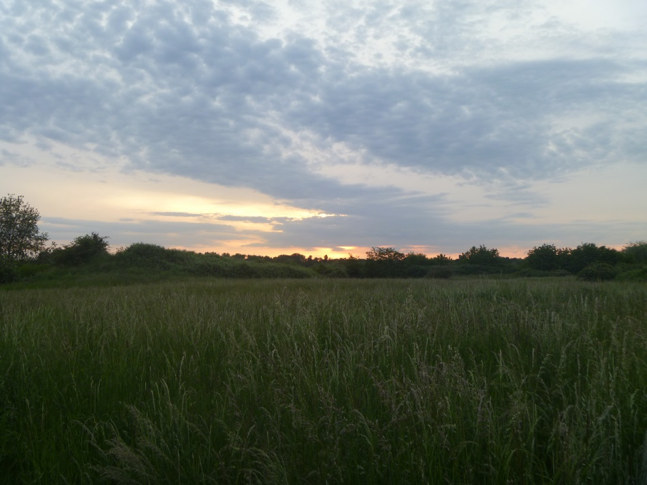
Your descent into Honeymoon Hole will be lined with wild roses, the occasional poppy, wasps’ holes, and sea buckthorn bushes which, during the right time of year, are laden with bright orange berries—the lemons of the north. If you follow someone going down and lose sight of them (maybe while raiding the sea buckthorn or blackberry bushes), it is possible to imagine they have emerged anywhere, and that when you come out on the other side there is only a marginal chance you will emerge in the same place.
To exhaustively catalog the flora and fauna you will find at the bottom of the hole would be both tedious and pointless. There are only two things that are essential to know about life after the initial descent. Everything else is extraneous.
One: The bowl seems infinite. It is not, in fact, all that large. Still, with nothing visible beyond the lip, how is anyone to know that the world hasn’t transformed itself into Honeymoon Hole —an endless recurring series of crater-landscapes becoming untamed, tendrils curling around and overtaking the manicured terrain? There is something reassuring about the greenery creeping over Europe’s industrial scars—particularly when life swallows an area so completely.
Two: The palettes. During any decent evening in summer, the sky is variegated sherbet; the largest lake, crowded with macro-algae, nothing short of emerald; the rest a sea of purple thistles and yellow daisy candelabras. All the greenery, so vibrant and abrasive during the day, becomes a dusty blue. These palettes shift constantly, mercilessly. I live for the moments in which every stone left in the hole glows dully with its own spectrum of oranges and purples, and occasionally greens. During these times, you, like me, will want to march off with handfuls of these subtly dappled talismans, but you have been warned—subtlety does not travel well. I have a pile of these disappointments in the corner that end up, cruelly perhaps, as drainage for my houseplants.
***
Another warning: if you count on having these displays to yourself, you will likely have to share. There are others, half the time at least, but there is no real way to anticipate them. You cannot know in advance who or what will await you in the bowl, but there is a recurring cast of characters who might make an appearance.
The most common, by far, are the middle-aged, walking their dogs; joggers, who you may try to hail, but who stop for nothing; and pairs or squads of kids who sometimes sit on the shore and blast bass music. A few times I have seen some of the locals: groups of two to three young men with massive, terrifying muscular arms, always with their equally muscular canine companions. I sneak past them as quietly as I can.
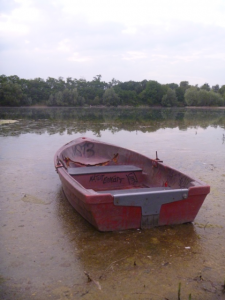
There is also the occasional lone fisherman, some of whom camp out with their shopping carts and trash heaps on the far side of the lake. Their spot looks inaccessible, but they must get to it somehow. I suspect they are responsible for a beat-up, sun-bleached red plastic canoe floating freely with the words Natur gehört uns (“nature belongs to us”) scribbled on it in big black letters. While I’m unsure who’s included in this “us,” I like to imagine they might extend it to me. But who knows—we don’t talk, and I’m not sure our cross-lake stare-downs actually take place.
And there are little old ladies, themselves tiny galaxies, that slowly spin around the top of the hole, but rarely venture down.
If you go often enough, there will surely be others, many of whom you will only ever glimpse once. One balmy evening, I saw a couple on one of the shores, just as it was getting very dark. They looked at me kindly as I emerged from my newt search, then spread out their blanket for a picnic. It was, as best I can remember, a crescent moon, and so they were bound not to have very much light, but they looked happy. When I got home, I, too, felt giddy, and my feet were dyed bright yellow. They would not come clean for three days.
***
Once, in an attempt to come to terms with these strangers, my companion and I (it was the two of us, after all, who named it Honeymoon Hole), conducted an experiment. Like so many seeking contact with something bigger than ourselves, we sent out a message in a bottle.
Setting it in a place we deemed lovely, but not too obvious, we constructed some stone circles and a little perch for the vessel containing the following note:
We nominate this place (“Honeymoon Hole”) to serve as a sacred place for the following activities:
- The observation of newts
- The smoking of pipes
- The finding of stones
- The experience of light (especially during sunrise and sunset)
We concluded by asking the reader for his/her own contributions. In the course of ten days, we received many additions to the list, some trite (“enjoying nature”), and some delightful (“eavesdropping on frog concerts”). We also inadvertently started a discussion about who the hole was for. “Joe” wrote that the police had given him a ticket because the space was “for nature and not for people,” asking whether the police often handed out such tickets. The police took it upon themselves to respond in the affirmative. That seemed not to deter others from leaving their own graphite traces, although I am quite sure we never heard from the fishermen.
Not that there was time. One evening, we dropped by as usual, to find the glass missing entirely, and the notes in shreds surrounding the rock structure. A few days later, someone had attempted to ‘re-naturalize’ the space, and scattered the stones so that they now formed no recognizable pattern. We did not attempt to reconstruct anything, but, a few weeks later, someone else had rebuilt the concentric circles. Will the glass show back up, I wonder, with a new list that attempts to carve out a place for us where the law will not?
Probably not: Honeymoon Hole seems to elude collective attempts to come to terms with it. It is as if it wants to belong to each one of us separately, gloriously, secretly—and not to everyone. Together we will never be able to wrap our heads around it, at least not adequately. Honeymoon Hole, nature, post-nature, whatever you want to call it, belongs to you and me, but it does not belong to us.
What is clear to me, and what I think is unveiled to anyone who stands in the middle of the bowl (even if they forget it on the way out), is that we belong to Honeymoon Hole. It is not only that we have some collective obligation to the life that flourishes there; it is much more basic.
Honeymoon Hole is not a platform that allows us to conceive of ourselves as distinct from the drama. It is a depression in the earth, a series of sunken strata, marking a time in which we no longer just watch, meddling here and there, but make and re-make. And in this hole, nothing seems inconsequential, whether it is a newt dragging a dragonfly into the macro-algae forest, or a rock launched by a human boy that skips and skips and skips. We have made a hole in the Earth, and it contains a universe.
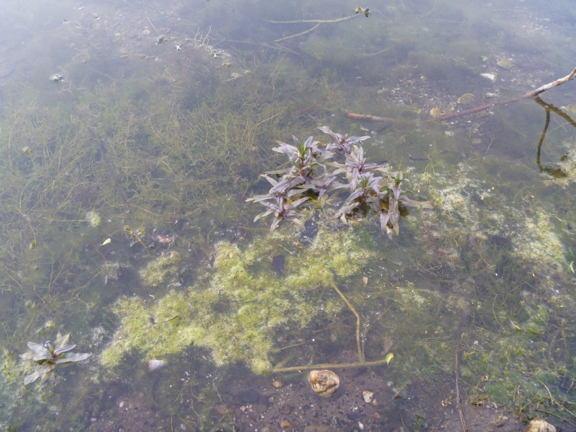
Bergwerkswald
It makes a difference, when falling in love, if you know the soil you’re scrambling over has been airborne in the not-too-distant past. It is as if the Earth has transformed itself for you and your beloved, even if you know full well it was a series of wars, waged by man against each other and the terrestrial distribution of the elements, that has done the transforming.
It was a forest that set my head, perhaps both our heads, spinning — a ruin so thoroughly reclaimed by life that its name almost seems a misnomer. “Bergwerkswald”: Mine Forest. The words don’t even fit together in English. First merely another dark Hessian wood, it would become punctuated in the nineteenth century by pits for extracting the iron and manganese deposits that lay there. It didn’t last forever, but by the time World War II came along, I like to imagine that much of the red and purplish exposed earth that betrayed the nature of the scars had been supplanted by blues and greens.
And then, on December 6th, 1944, the ten percent of the bombs that did not fall on the nearby city of Giessen rained down here, in the forest. I started walking through the Bergwerkswald some 60 years later, and by this time the craters had become an exquisite necklace of ponds, all framed by moss, and not one like the other. On the days when the largest pit, nestled in the chalk cliffs, was an especially gem-like aquamarine, or the time had come for thousands of tiny midwife toads to crowd the shores, or when I sat on the giant upturned trunk with the man in question and we proclaimed it majestic—I was unabashedly thankful for the way that even war gives way, here and there, to the serendipitous.
If I attach anything like hope to landscapes that have been pried apart and blasted, it springs from these glorious puddles.
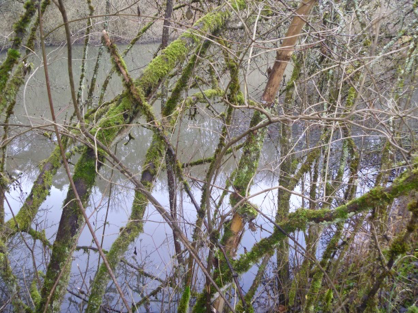
***
My reverence for them, at least in part, is explained by a myth I would recite silently to myself sometimes; like all creation stories that stick, it explained perfectly the role my ancestors had in blasting and forming the ground that I tread. My grandfather, in real life, had been a navigator aboard one the B-52’s that had bombed Hessen, and Giessen, a remarkably unattractive Hessian city, would not allow me to forget it. But my fantasy, as I trampled through the woods and studied the reflections in the ponds, was that he had purposefully led his aircraft astray. While the others made short work of the half-timber homes and many of the inhabitants, my grandfather intuited that the child of his future child would much prefer a bit of artful terraforming in the woods to the usual assault on civilians. And indeed I do—if we must have military aircrafts and bombs, they could do worse than landscaping.
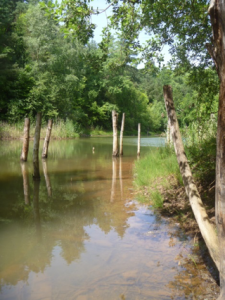
I fully realize the unlikelihood, bordering on delightful absurdity, that my grandpa spent his time in the war gardening from the air. But my brain will not let go of the story. However delusional it may be, it ties me to an explosive force brought to bear not on human bodies, but the land. I am not entirely hostile to the latter, at least in moderation. The Bergwerkswald reminds me that, even in the midst of war, we do not always lay waste. Kill, devastate—certainly; I have no doubt that the arrangement of the elements affected by the bombs had its own casualties. It cannot, at first, have been anything like the landscape that calls out to me in dreams. It took time for life to creep, and then to scurry, over those bald, yawning craters.
***
The ponds, as they are now, are unthinkable as anything else. They are simply there, and their intractability, rather than their virginity, is what calls out to those who frequent them. My companion and I said as much to each other as we wandered among them, from the large, unearthly aquamarine dropped carelessly by giants, to the dark holes filled miraculously with lily-pads, to the marshy shallows punctuated by grassy tufts that can only be gnome dwellings. At the time, I fooled myself into thinking that the Bergwerkswald was merely background, albeit a luminous one, but now I cannot separate our time from this place.
Love (and not just romantic love), is indeed a battlefield, but more akin, in my experience, to the Bergwerkswald than to the trenches. And the battle, in most cases, has already happened; you may fight one another, but mostly you work to repopulate the chasms, potholes, and scars that existence, in all its violence and carelessness, has blasted and pried open. It takes time for life to creep, and then to scurry, over those bald, yawning craters.
***
Even with a few years behind me, I don’t know if I felt the Bergwerkswald stands in my mind for me, or the man I fell in the love with, or that which emerged between us. Perhaps it was all three at once. What I do know is that, together with Honeymoon Hole, it is our verdant, pock-marked, intricate common ground. We marveled in and at it together, because it was there and because it was incontrovertible, but also because it was so recently not there and could have easily never been at all.
